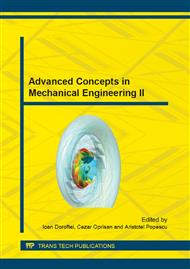p.201
p.205
p.211
p.217
p.223
p.231
p.237
p.243
p.250
Safety against Derailment for Railway Vehicles
Abstract:
The shock attack occurs at a railway vehicle circulation in a curve in which a discontinuous bend appears, mathematically represented by an angular point. In this point, shock angle produces an abrupt change of direction of the vehicle, respectively a dynamic shock force.The paper presents a mathematical model used to determine the dynamic force shock and its influence on vehicle guiding safety. The study was applied to the tank wagon on bogies for transportation of petroleum products, because such vehicles generally have derailed at circulation in curves in which have occurred accidentally discontinuous bends.It shows that the dynamic force may lead to an unacceptable increase of guiding force Y at leading axle of the vehicle, and therefore to overcome the (Y/Q)lim, which defines the limit of derailment, Q being the load on the attacking wheel.The conclusions indicate constructive measures to be taken to ensure the safety of the vehicle guiding at circulation in curves.
Info:
Periodical:
Pages:
223-230
Citation:
Online since:
October 2014
Keywords:
Price:
Сopyright:
© 2014 Trans Tech Publications Ltd. All Rights Reserved
Share:
Citation:


